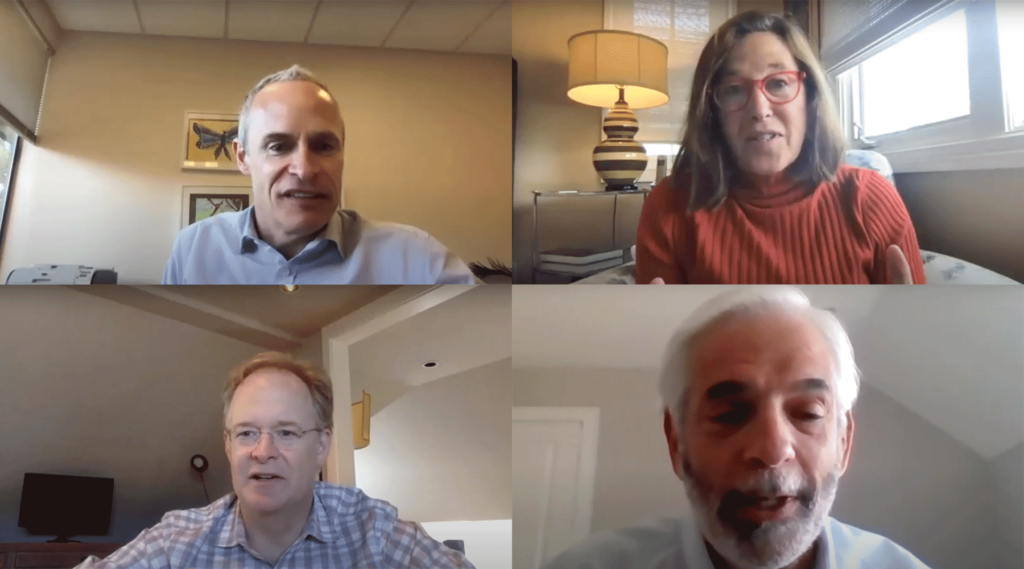The COVID-19 crisis has led to an unprecedented increase in the use of telemedicine. To assess what that means for healthcare now and in the long term, the USC Schaeffer Center for Health Policy & Economics gathered experts for a widely viewed webinar on May 19.
The forum was moderated by Bob Kocher, MD, a senior fellow at the Schaeffer Center and a member of the California Public- Private Coronavirus Testing Task Force. The panelists were Leslie Saxon, MD, Cardiologist, USC Professor of Medicine and executive director of the USC Center for Body Computing; Hill Ferguson, CEO of Doctor on Demand; and Andrew Dreyfus, President and CEO, Blue Cross Blue Shield Massachusetts.
The demand for medical care and advice that doesn’t require an in-person appointment has soared in recent weeks, and may signal a transformative moment for telemedicine. Dreyfus said that Blue Cross Blue Shield Massachusetts saw telehealth visit claims soar from 200 daily in February to 40,000 in April and May. Total behavioral health visits held steady as the coronavirus crisis intensified, but almost all of the visits shifted to the virtual format, he said.
Doctor on Demand had some difficulty recruiting providers to its model when it began seven years ago, but now has a backlog of doctors applying to be part of the platform, said Ferguson. Wait times for a patient to talk to an urgent care doctor that averaged 5 minutes before the coronavirus hit ballooned to two hours, but are now back to around 5 minutes as more providers come aboard, he explained.
Saxon said the implications for patients and the medical system are profound. “We are looking beyond telehealth,” she said. “This is a transition period.”
She envisions a new service model which empowers patients with data from wearable and implantable devices, coupled with the efficiency of reaching a doctor easily over telemedicine channels. “We are leveraging the patient in their own care,” she said. This is especially important for patients with chronic conditions who can share data with physicians from the last few days or when a symptom was occurring, who can in turn quickly reach out for second opinions as needed. “We are jailbreaking information from specialists’ brains,” she said.
Once patients have experienced virtual visits, they seem sold on the approach, Dreyfus said. Providers who were worried about the limitations of telemedicine tell Hill that they didn’t realize how much they could do remotely. They can engage patients between visits and become coaches. “We’re definitely not turning back,” he said.
Kocher asked Saxon how she can untangle electronic signals from patients that might just be signs of aging and not a reason to intervene. The data is pouring in, Saxon said. “We have to try to understand it. It takes restraint and expertise. We have to validate and use predictive models.”
Saxon predicted that traditional medicine will not embrace a telemedicine revolution on its own. “Traditional medicine is not capable of disrupting itself,” she said. Electronic health records were supposed to dramatically improve medical practice, but doctors soon recognized that they were primarily a billing device. “Virtual live care has to come out of a different model,” she said.
Kocher asked if telemedicine will lower health costs, and how do we design payment systems for it?
Dreyfus said that the experience with telemedicine during the COVID-19 era might give a boost to global payment systems which guarantee revenues without fee for service constraints. The problem will be the uncertainly that the COVID-19 experience has generated throughout the healthcare system. It might make it harder to commit to new value based systems, he said.
Kocher noted that medicine has been delivered locally for generations, and asked how telemedicine might change that. Dreyfus said “local still matters,” but that for rural areas telemedicine has been a huge benefit. Saxon added that catastrophic care clearly needs to be handled in person, but that second opinions can now be obtained from the best specialists anywhere.
Kocher and Dreyfus both serve on the Schaeffer Center’s advisory board. More about what the Schaeffer Center is doing on COVID-19 can be found here.
